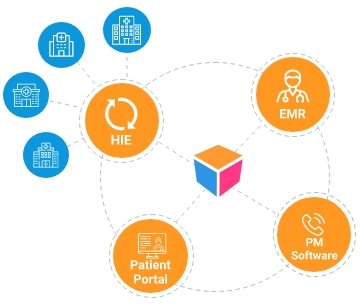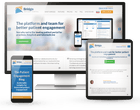Healthcare Web App & Portal Development
We Build Custom Web-based Software for Healthcare Organizations
Trust the Experts in Custom Patient Portals & Web Software
If an out-of-the-box software solution isn’t right for your business, a custom healthcare portal or web application could help you meet the needs of your patients or users, as well as reduce inefficiencies and increase revenue.
We understand the unique challenges that healthcare businesses face, and we know how to solve them. We specialize in creating software solutions with both your users and their PHI in mind, meaning an easy-to-use interface and 100% HIPAA compliance.
Usability. Interoperability. Scalability.
No one knows patient portal development better than we do. We’re the developers of healthcare’s leading patient portal solution, Bridge Patient Portal, and have been developing custom portals for clinics, health systems, labs, and more since 2010.
Whether you need a stand-alone system or a web application that works in conjunction with your existing medical software, we’ve got you covered. We specialize in building healthcare portals and medical web apps that are made to be loved by end users, but also made to help your organization meet its business goals.
Experts in Patient Health Portal Technology for Provider Groups
We build custom patient health portals for physician practices, clinics, health systems, hospitals, and more. We work with provider groups to understand each client’s unique needs, and develop a solution that’s perfect for them.

Features Your Patients & Staff Will Love
Set your organization apart from your competitors. Custom-built features increase convenience for your patients, while also improving your internal workflows.
Features can be built as an add on to your custom patient portal software, or as a stand-alone web application.
Patient Scheduling Solutions
Allow your patients to schedule an appointment online, through their computer or mobile device. Bidirectional interfaces with your existing patient appointment scheduling system eliminate the need to approve requests.
Transportation Solutions
A significant portion of missed appointments are due to a lack of transportation. Offer your patients rides to and from their appointment using an integration with Uber Health. The patient can request a ride using your portal or mobile app, and does not need to have an Uber account of their own.
Telehealth Capabilities
Integrate your portal with your existing telehealth solution, or create a custom VoIP and WebRTC-based video chat, messaging, or phone solution just for your organization.
E-commerce Solutions
We build custom portals that allow healthcare e-commerce businesses to sell products and services online in a HIPAA-compliant way.
Online Bill Pay
Allow patients to clear unpaid invoices online through your website, 100% securely and PCI-compliant.
Email or SMS Notifications & Appointment Reminders
Reduce no-shows and engage patients with HIPAA-compliant email or SMS notifications. Send notifications before an appointment, when test results are ready, medication reminders, and more. (For the ability to send push notifications to a user’s mobile device, consider medical mobile app development.)
Data Reporting & Analytics
Gather invaluable data on usage over time, and use your insights to make key decisions on new features, functionality, and more.
Remote Patient Monitoring
We build custom integrations with wearables, including Apple Watch and medical devices, as well as custom reporting and data-tracking features.
Triage & Chatbots
HIPAA-compliant chatbots and triage solutions improve communication between you and your patients, and allow you to funnel patients to the correct department quickly and efficiently.
Patient Intake Solutions
Reduce your processing time by allowing patients to submit patient intake forms online prior to their appointment.
Prescription Ordering & Adherence
Allow patients to request refills online, securely message their providers with medication questions, and send medication reminders via SMS or email. (For the ability to send push notifications, consider developing a healthcare mobile app.)
Communication & Messaging
HIPAA-compliant secure messaging through your portal, or as a standalone app through your website, engages your patients and gives them another way to get in touch with their provider.
E-signatures & Document Signing
Allow users to create an e-signature and sign documents through your web app or patient portal, which eliminates the need for the user to sign documents in-person at your office.
Custom Patient Care Plans
We design and build custom, easy-to-use care plan features that allow providers to build detailed plans and better communicate each patient’s needs.
Advanced Login Capabilities & Authentication Methods
Offer different levels of access for providers, caregivers, and care coordinators, as well as linking families within the portal. Increase security and reduce the risk of unauthorized logins with 2-factor authentication and other advanced verification technologies.
Companion Healthcare Mobile Apps
We specialize in custom healthcare mobile app development for iOS and Android, which gives your web-based software a companion app and expands your range of available features and services.
Custom Patient Portal Development for Labs
Pre-built lab result portal solutions don’t work for every lab. If your lab has unique needs, custom lab software can help improve efficiency, increase profitability, and grow your business.
LEARN MORE ABOUT LAB RESULT PORTALS
- Patient and referring physician retrieval of documents (ie. lab results)
- Patient registration/intake workflows
- HIPAA compliant email/SMS notifications
- PCI compliant online payments
- Interfacing with lab and dispensing equipment
- Interfacing with to Labcorp
- Interfacing with to PBMs
- Companion lab mobile apps
- And more.
Pharmacy Patient Health Portal Solutions
Unique pharmacies have unique needs – and we know how to meet them. We build custom web-based software solutions and portals for pharmacies and pharma-related businesses that are designed to help those organizations streamline workflows and scale up.
Custom patient portal development allows pharmacies to offer greater convenience to their customers by moving key services online. You’ll be able to offer features like:
Our user-experience-focused pharmacy portal designs make medication management easier for patients, while also integrating with your existing internal pharmacy management software to simplify your workflows.
LEARN MORE ABOUT PHARMACY WEB DEVELOPMENT
- Prescriptions management
- Medication adherence tools
- Refill reminders
- Online refill ordering
- Patient-to-pharmacist messaging
- Drug information
- Companion medical mobile apps
- And more.
Healthcare Portal Integration: Seamless Interfacing with EMR, LIS, & More
Efficient sharing of information across disparate systems means better care delivery, improved collaboration, and higher patient engagement. Our custom patient portals for healthcare help you do this, in a way that works for your healthcare organization.
We’ve been building integrations between custom healthcare portal solutions and EHR, RCM, PM, RIS, LIS and HIE technologies since 2010. Our team has successfully implemented CCDA, HL7 and FHIR standards to facilitate the exchange of clinical records, lab results and more across health systems, hospitals and provider networks.
We build integrations with:
- Electronic health record (EHR) or electronic medical record (EMR) software
- Revenue cycle management (RCM) software
- Practice management (PM) systems
- Laboratory information system (LIS) or lab information management systems (LIMS)
- Radiology information system (RIS)
- Pharmacy information system (PIS)
- Health Information Exchange (HIE)
- Pharmacy benefit manager software
- Existing patient portals
- Patient scheduling software
- Customer relationship management (CRM) software
- Custom databases
- And more.
Bridge Patient Portal: A Customizable Patient Health Portal Platform
For healthcare organizations that don’t need a fully-custom portal, Medical Web Experts’ partner company Bridge Patient Portal offers an out-of-the-box yet versatile and customizable alternative. Bridge Patient Portal provides a superior user experience for patients, providers, and administrative staff, as well as a broad range of patient engagement features.
For provider groups looking to replace their EHR’s existing patient portal, or to connect disparate EHR environments with a single EHR-agnostic patient portal platform, Bridge offers a patient health portal that can meet your needs with minimal setup time and a lower cost than a fully-custom portal.
Bridge Patient Portal includes features like:
- Patient engagement reporting
- Care plans
- Personal health records
- Custom patient forms
- Appointment requests
- Prescription refills
- Online bill pay
- Multiple concurrent, bi-directional EHR/PM/HIE interfaces
- Secure messaging
- Advanced patient authentication
- Private-label branding
- Mobile-responsive design (works on iOS, Android, tablets, and any other mobile device)
- Medical record sharing
- Multilingual support
- iOS and Android mobile apps
- Multi-tenant support (multiple facilities)
100% HIPAA Compliant Patient Portal Development
HIPAA is complicated, and failure to comply can be costly. You need a partner who understands the challenges facing your organization, and can practically apply measures to ensure compliance. With our proven suite of HIPAA compliant website development and HIPAA hosting products, you can have the confidence that you’re taking the right steps towards compliance with your healthcare portal.
Regular audits by our internal compliance officer as well as annual third-party HIPAA audits are just some of the ways we demonstrate our commitment towards compliance. These services are extended to our clients as well.

